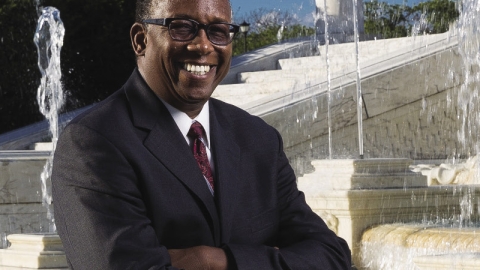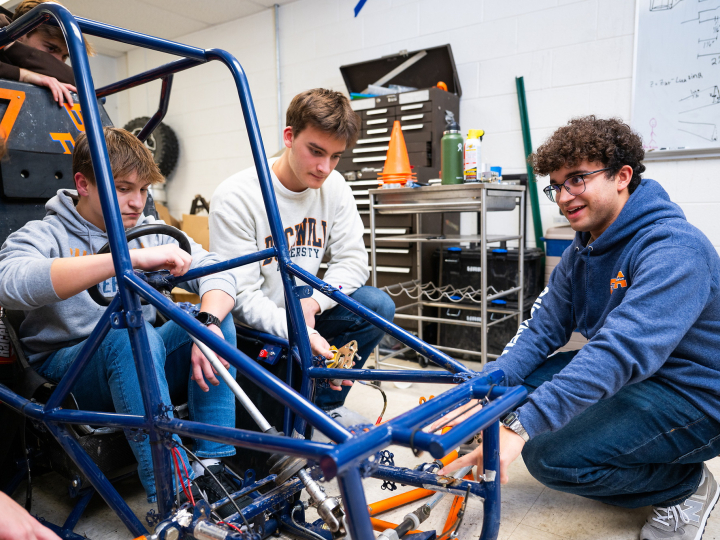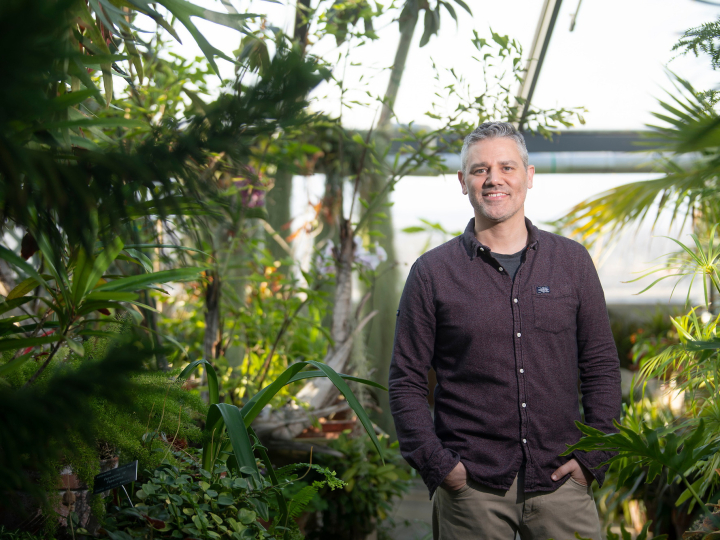
City of Hope
January 21, 2015
Guy Williams '76, an environmental activist, has spent 20 years helping Detroit make its comeback.
By Kim North Shine • Photography by David Lewinski
In the post-war 1950s, Detroit was one of the most popular cities around. People of all nationalities and backgrounds were attracted to its red-glowing steel mills, its auto factories, the promise of good wages and nice, affordable homes.
But as the highway system snaked out to former farmlands paved over with shining, new suburban subdivisions, people found it easier to leave. And they did — in scores. A divisive conflict between police and community members in 1967, what some have dubbed the 12th Street Riot, further fanned the desire of many to depart.
Soon, much of its luster had eroded. Detroit — once a booming metropolis — had become home to many empty plants and factories. The pollutants they left behind marred its beauty and made much of the land, air and water unsafe. Eventually a city once loved by 2 million people would lose about half of its residents, as they moved away for job opportunities or suburban living. Their departure gave way to a proliferation of empty neighborhoods. With economic potential drying up, homes falling down and empty office spaces, Motown was singing the blues.
But while so many people were looking for a new place to call home, Guy Williams ’76 was heading straight for Detroit.
It was 1994, roughly 30 years since the Motor City’s decline began, when Williams saw Detroit for the first time. It didn’t take long for him to care deeply for this French-founded, American heartbreak of a city, which seemed so out of place in the gorgeous and verdant Great Lakes State.
While his affection for Detroit blossomed, it was the people who stole his heart — those with no or very limited opportunities; those living in the shadows of odorous manufacturing plants and in the environmental aftermath of lead smelters; those stuck in unsafe neighborhoods pocked with burned-out homes; those with little apparent influence on government and corporate policies that have so much impact on their lives.
“When you care about something, you want to make it better,” Williams says. He had never visited Detroit, but when he arrived there, he saw so much promise. “I had no hesitation,” he says. “It was where I wanted to be, and I knew it was where God wanted me to be and to work.”
Environmental justice was a little-known term 20 years ago when Williams, now 61, moved from Washington, D.C., (where he had worked as a project coordinator with the Environmental Defense Fund) to Ann Arbor, Mich., to help start a pollution-prevention program for the National Wildlife Federation (NWF). That same year, Williams teamed up with others who were already working for change in Detroit. Together, they started Detroiters Working for Environmental Justice (DWEJ). “The people who formed the nucleus of DWEJ were already there and already working,” says Williams. “They were a source of inspiration to me, and welcomed me into their body of work. For that, I am forever grateful.”
But it was a lawsuit focused on improving water quality in the Great Lakes and sewage treatment in Detroit, just half an hour from Ann Arbor, that put Williams on the map as a top environmental thinker — and gave him a close-up view of the city. As a project coordinator for NWF, Williams and his colleagues documented high levels of mercury being released into waterways through the sewage system and recommended methods for controlling it while the lawsuit was argued over several years.
Among the information they documented in the case was the fact that in 1995, four pounds of mercury entered the Detroit River each week. The river feeds Lakes Erie and Ontario, and the mercury was poisoning the fish, wildlife and nearby residents. Pregnant women and children in particular were affected, as the rate of birth defects in the area increased. “Seventy communities were using the same water system for drinking and sewage,” says Williams. “We figured that if we could clean up that one major source to the lakes, it would be a great victory and would make a major difference.”
It was indeed a great victory. When the lawsuit was finally settled in 2002 with the defendants agreeing to implement the changes sought by Williams and his colleagues at NWF, cities around the country replicated the same mercury remediation plan they had designed. The changes imposed some of the strictest environmental protections in the U.S.
Their seminal work initiated some of the first collaborative pollution-prevention strategies in the country and helped form the basis of a new organization called Health Care Without Harm, now a group with international impact. Among its results was the prevention of hundreds of pounds of mercury from being dumped by dentists each year through the establishment of alternative disposal methods and incentives for using mercury-free amalgams. In an initial award program, 14 Michigan hospitals agreed to limit the use of mercury, two of them by 80 percent. Industries such as battery makers complied as well. In fact, standard practices in the healthcare field and the design of many commonly used products were soon transformed to include mercury-free formulas.
The experience was an eye-opener that convinced Williams to pay more attention to local issues and to work with people at the neighborhood level as a way of complementing the national and worldwide interests he had focused on with the Environmental Defense Fund and NWF.
With the landmark lawsuit and a successful run with NWF under his belt, Williams’ career path took a turn toward other forms of environmental justice in the city. It’s a path that has wound through countless projects, initiatives and concerns across all levels of government and business. Altogether they have taught him the importance of connecting with people in the poorest neighborhoods and in the highest halls of the state and nation’s capitols, where, he says, decisions may seem far removed but are what truly determine quality of life.
“Environmental justice is making sure everyone has a safe place to live, work and play. But unfortunately, there’s also a world of great environmental injustice, and it’s people of color who get the short end of the stick,” he says.
The gist of his work many days is grassroots and on-the-ground. As the president and CEO of DWEJ, Williams knows priorities and the greatest needs can change daily or weekly, and that nothing is ever completely checked off the to-do list.
“You never know what type of situation you will face when a day begins,” says Williams, who is also the owner of G.O. Williams and Associates, an environmental and sustainability consulting practice that works with companies and nonprofits to boost their bottom lines while injecting an environmental conscience into their organizations through environmental justice practices, education and increased local engagement.
Over the years, Williams has battled on behalf of Detroit and its people, arguing for solutions to deal with the effects of steel mill emissions; dust from heavy truck traffic; the nation’s largest municipal waste incinerator; thousands of parcels of contaminated land; and now-inoperable lead smelters, thought to be the culprits behind the high number of Detroit children with lead-related illnesses, as well as cognitive and behavioral issues. These sources of pollution and others have had a collective impact on the city and its people, a net effect demonstrated by an unusually high number of low birth-weight babies, cancer hot spots, high asthma rates and deaths.
The list goes on, and so does Williams. He clocks more than 30,000 miles a year on his car, with an eclectic playlist of music — everything from the Temptations to Prince to a cappella Bach arrangements — providing a soundtrack on his drives from Ypsilanti, where he lives, to any number of different cities each day. A call from a DWEJ team member or an email from a community activist sets him in motion.
“I tend to be soft-spoken and understated, not flashy. My style is more steady and determined, like a Crock-Pot, than hot and fast, like a stir fry,” he says with a smile. “I have been blessed with a wide range of life experiences that help me communicate well with basically anyone. This is one of my strengths. I can connect with people at any stage of life. I can hang with company presidents and CEOs or be on the street with addicts and have no fear,” he says. “I have a knack for seeing across different points of view. You won’t get movement on an issue if you can’t see all points of view.”
Getting people to lend an ear in the mid-’90s, especially in government, was challenging in a city where pro-manufacturing mayors and other leaders saw environmentalists as threats to the economy capable of restricting positive business growth. There was no vision for Detroit, says Williams, that included creativity or innovation when it came to being a “green” city or a leader in sustainable redevelopment. This is a city, after all, that is only a few months into citywide curbside recycling, commonplace in many cities for many years now.
“Because Detroit leaders and the power center of Detroit were all linked to manufacturing, many of us who were trying to speak to businesses on topics of change were not welcome,” says Williams. “It was very tough to get anyone in the business community to listen.”
The rejection pushed Williams and his counterparts to resort to the time-tested power-in-numbers approach and band together with people from small grassroots groups to form DWEJ. “The reason we formed was that there was no other organization like it — even though Detroit was emblematic of everything that inspired the environmental justice movement,” he says. In trying to reverse the difficulties, Williams encountered many closed doors.
But eventually they got the attention of decision makers. Kenneth Cockrel Jr., longtime Detroit City Council president who served a stint as interim mayor in 2008 and 2009, was one of them. He was open-minded and understood sustainability, Williams says. He listened. The two also worked together on a City Council green task force.
Giving Williams and DWEJ a seat at the table back in his council and mayoral days “was a no-brainer,” Cockrel says. “As mayor, I believed then and still believe that Detroit needs to have a sustainability agenda. Such an agenda needs to be interwoven into the day-to-day operations of every single department. DWEJ was one of the first organizations to not only recognize this and advocate for it but to also take a grass-roots approach to mobilizing Detroiters around that agenda.”
Today Cockrel is the executive director of Detroit Future City (DFC), the organization responsible for implementing the city’s strategic redevelopment framework. Williams serves on a steering committee for DFC, and has served in other roles for the organization as well, speaking on behalf of residents not privy to DFC decisions that could affect them. “The appointment gives me the responsibility to work at expanding opportunities for legitimate neighborhood voices to play a role in shaping the Detroit Future City agenda,” says Williams.
As the DFC framework is coming to life, Cockrel is confident in the value of Williams’ input. “He not only brings the environmental justice perspective to the table, but most importantly, he brings a way of thinking that is tremendously beneficial to the discussions,” he says.
Cockrel says Williams has the ability to ask “important questions during discussions that lead us to think about the subject at hand in a completely different way. He is a very creative, dynamic thinker. He is truly a living embodiment of the phrase, ‘Don’t just think outside the box. Think as if there is no box.’”
“One of Guy’s many great strengths is his ability to bring people together who may have different perspectives,” says Catherine Nagel ’84, executive director of the City Parks Alliance in Washington, D.C. “And as the city recovers, he works hard to make sure those who have been in Detroit the longest are not left behind.” Nagel and Williams met a few years back while working on a Georgia Tech Research Institute project, Red Fields to Green Fields. They helped analyze dozens of cities, including Detroit, in a search for ways to return underutilized properties such as industrial parks and strip malls to productivity.
Williams obviously is not alone in wanting to heal Detroit’s heartbreak, and he has made a name for himself right alongside lifelong Detroiters who are fighting the fight. It’s hard to believe he is not a child of the city that birthed the labor movement. “I sometimes find myself forgetting that Guy is not only not a native Detroiter but also doesn’t live in Detroit currently. I think that’s really a testament to the hard work he has put into getting to know the city, its people and its issues,” Cockrel says.
Families like the Moores are waiting for safer, cleaner neighborhoods; they’re waiting for the comeback. Leslie Moore and her grown daughters Ricci and Lark moved away from the city because they wanted to feel safer and receive a better education for the children in the family.
“We love Detroit, but it can be a hard place to live. We still have family there. Their homes are okay; they take care of their homes. But just two doors down, there’s a crack house or a slumlord always kicking someone out for not paying rent. It’s hard to find a home in a neighborhood that’s still whole and good,” says Leslie. “As bad as it seems sometimes, you can see it’s getting better. People are actually moving back.”
To be clear, there are pockets of low- and middle-class neighborhoods hanging on, people raising families. Other parts of the city, Midtown and downtown, are on the verge of gentrification. Still, the common go-to references to Detroit as “war-torn” or “bombed-out” persist.
Reversing that is at the heart of the city’s plan to demolish some 80,000 blighted homes, but even that has its environmental and social complications, and Williams is working to protect the people in the path of destruction.
“What we know now is that we are doing demolitions on an unprecedented scale, and it’s happening more quickly than ever, at about 200 homes per week. That’s partly because federal funding needs to be spent, but it may be too fast,” he says, hoping to slow it down and urge caution. “In other words, if this is done too quickly, clouds of lead dust could be released all over town, and the impact of that will be long-lasting. We’re working really hard to study the effects, looking at other cities — Chicago, Philly, Baltimore — to learn how they contained the dust and protected people.”
Williams, who was recognized last year with the Detroit Free Press’ 2014 Green Leader Award, has learned that success in his line of work is plodding. “Regardless of victory or defeat, you need to be prepared to take on issues for the long haul in order to succeed at positive transformation. History has taught me that the best outcomes feel like they take forever. You have to be committed to the long-term or don’t take on the issue.”
Pinned to a corkboard in his office at Detroiters Working for Environmental Justice is a map detailing a vision for an eastside Detroit greenway network. Although it’s an ambitious vision, Williams has great hope that things will continue to improve in a city that’s showing the benefits of a rediscovery and a can-do attitude, like the positive plans for neighborhood investments for safety and prosperity, the growth of the downtown area, the farm and the urban agricultural movements, the relocation of major companies to downtown and Midtown, investment by business owners in numerous projects and improving transportation options.
“My dream is to see a city that is vibrant across all aspects of the society — a place where the current disparities of power, wealth and education are greatly reduced, and where the voices of the ‘people-at-large’ are always heard and respected by decision makers. I try to do my part toward this end, day in and day out.”
That dream is Detroit’s future — and Williams will be right there to witness it.
Kim North Shine is a writer living and working in the Detroit area.

